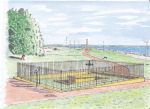The latin inscription on the grave reads: “Here lies L. Receveur French Priest of Friars Minor, scientist in the Voyage Around the World under the leadership of de Laperouse, died February 17th, 1788.”
Claude-Francois Joseph Louis (Laurent) Receveur was the junior of the two chaplains on the Laperouse expedition which arrived in Botany Bay on January 26th, 1788, the very day that Phillip and the First Fleet were moving to Port Jackson.
Receveur was born April 25th, 1757 in Noël-Cerneux, a village in Eastern France with a population similar in size to La Perouse. He was a Conventual Franciscan friar at a time when the Conventual Franciscan branch of the Friars Minor occupied the Grand Convent in Paris. A man of letters, he was amongst the 17 scientists who accompanied Laperouse, serving aboard L’Astrolabe as a naturalist, astronomer, botanist, geologist, chemist, meteorologist and philologist.
In a description of the young friar Mr de L’angle, Captain of L’Astrolabe, wrote “ Father Receveur carries out his duties as chaplain with decorum; he is friendly and intelligent; while at sea he deals with meteorological and astronomical observations and when we are at anchor, with matters related to natural history.” Laperouse describes him as an “indefatigable naturalist” but one who was obviously not without spirit. In Macao, he was one of four scientists detained aboard ship for 24 hours after a quarrel with the Commander. On Easter Island he is recorded as descending into an extinct volcano, with an estimated depth of 800 metres, and reporting that it contained “the finest banana and mulberry plantations.”
Over the course of the expedition, there were numerous scientific explorations where Receveur figured prominently and which Laperouse recorded in his journals. These included the brutal massacre in Samoa which claimed de L’angle, senior scientist Lamanon and ten other members of the expedition, and left Receveur with, as Laperouse recorded, “a bruised eye”.
In the final letter written to his brother while in Botany Bay, Receveur claimed that the injury had healed but within ten days he was dead. At every opportunity during the voyage he and his fellow scientists were in the field examining, collecting and recording their scientific discoveries. In Botany Bay their presence was met with hostility by the local aborigines. Receveur may well have fallen victim to that hostility or succumbed to unseen complications of the eye wound. In death he became the first scientist, the first catholic, and the first priest to be buried in Australia and the burial mass conducted by the senior priest and fellow scientist, Abbe Jean-Andre Monges, would have been the first celebration of the Catholic mass in Australia. The Laperouse Expedition departed Botany Bay on March 10th, and subsequently perished in Vanikoro.
On June 1st 1788, John White, Surgeon-General of the First Fleet and the Settlement at Port Jackson, visited the site of Receveur’s Grave along with Governor Phillip and recorded the following in his Journal : “After breakfast we visited the grave of the French abbé who died whilst the Count de Peyrouse was here. It was truly humble indeed, being distinguished only by a common head-stone, stuck slightly into the loose earth which covered it. Against a tree, just above it, was nailed a board, with the following inscription on it:
HIC JACET
LE RECEVEUR
EX F. F. MINORIBUS GALLIA SACERDOS
PHYSICUS IN CIRCUMNAVIGATIONE MUNDI
DUCE D. DE LA PEYROUSE.
OBIIT DIE 17th FEBR. ANNO 1788
As the painting on the board could not be permanent, Governor Phillip had the inscription engraved on a plate of copper and nailed to the same tree; and at some future day he intends to have a handsome head-stone placed at the grave. We cut down some trees which stood between that on which the inscription is fixed and the shore, as they prevented persons passing in boats from seeing it.”
In March 1824, Louis-Isidore Duperrey visited the headland and a young French officer carved an epitaph on the trunk of the eucalyptus tree which marked Receveur’s grave. The tree was later removed and the engraved portion presented to France.
In 1825, while on a visit to Port Jackson, Baron Hyacinthe de Bougainville arranged for the construction of a monument to Laperouse and a Tomb for Receveur. The project was supported by Governor Sir Thomas Brisbane who allocated 176 sq. yards for the monument and 70 sq.yards for the tomb. In an official dispatch to the Minister for the Navy, de Bougainville wrote: “I discussed my plans with Governor Brisbane who welcomed them all the more since on the opposite side of the bay, he himself had recently arranged for a plaque to commemorate the arrival of the immortal Cook. H.E. had no hesitation in granting me the requested site and has kindly agreed to entrust the creation of the mausoleum to the government architect.” The tomb was completed in 1829.
The altar stone that Monges would have used during the burial mass along with the engraved portion of the tree trunk, and a number of other items were given into the Laperouse Collection as a Bicentennial Gift to Australia by the French Government in 1988. The Collection is housed in the Laperouse Museum at La Perouse. Over the years many have come to celebrate mass on the anniversary of Receveur’s death.
Images: L - Receveur Grave with Laperouse Monument in Background, June 2008, A.Francey; R - Botany Bay 30 Novr. 1842. [Landscape with grave. Inscription on tree “F.T. Larsen / Les Restes / Receveur / te Tars”], by Oswald Brierly



You must be logged in to post a comment.